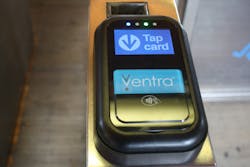In the fall of 2013, the Chicago Transit Authority (CTA) launched the Ventra Card in a sweeping change in how it collected fares in order to provide a next generation payment system to serve riders.
The new system was aimed at ending the old Chicago Card fare system and moving CTA into a new open fare payment system. Leaders worked on the system and educated northeastern Illinois about the change in payments and how it worked with extensive outreach and education.
But even with all the work it took, CTA leaders had to face a hard truth before the system went fully implemented with Ventra in July 2014 — being the first to bring a new technology into the market is difficult.
“It’s hard to roll this out and be the first with this technology because nobody else can confirm or disprove our assumptions or model for customer actions and behavior changes that occurred,” said Mike Gwinn, director of revenue and fare system for CTA. “We were all out on our own at the front of everything and we had to be able to react and make improvements.”
Ventra was implemented in CTA and Pace Suburban Bus, but after the initial rollout of the system, Chicago media was critical of the system, with riders complaining of overpayments, systems not working and call centers not responding to their inquires.
Gwinn said they needed to make improvements in order to win the public’s trust back in the system, so first and foremost, CTA took a look at the issues from the customer experience in order to see what wasn’t working.
Getting Smart
Leanne Redden, executive director of the Regional Transportation Authority (RTA), said the organization began pushing Chicago area transit agencies to a new fare system years before Ventra became a reality. The technology would allow customers to more easily use all systems and the Chicago Card was becoming outdated, so Redden said they presented the agencies with studies on a new fare payment system, supported state legislation calling for a change and funded projects via grants to push the change forward.
“To start with, RTA is specifically precluded from sort of setting fare controls persay, but we can guide policies, but fare controls are squarely under the purview of the service boards,” Redden said. “We kind of worked to nurture and support and educated in some cases.”
Redden said CTA had a lengthy procurement process for getting into Ventra, so RTA worked to make sure Pace could work into the deal. It was expected Metra would be behind CTA and Pace given the different function of the system, but Redden said RTA worked behind the scenes for years to make sure Metra would eventually be able to come into the fold.
“RTA pushed in this whole conversation that we didn’t want to be boxed in like the old Chicago card. We wanted to move to an open payment system and get the transit system out of the business of printing its own currency,” Redden said.
Cubic was awarded a 12-year design-build contract for Ventra and to run the call center once it was operational. Sushil Rajendran, vice president of operations, North America, Cubic Transportation Systems, said handling multiple forms of payment options meant not only preparing the system for different card and mobile payment technology, but also addressing regulations between payment brands.
It also needed to work with the CTA and Pace fare policies and eventually Metra’s as well.
“It would be nice to have standardized fare policies…and it does make the design of the system easier, but on Ventra we designed to CTA and Pace business rules and we did not go about asking them to standardize,” he said. “Our contract was to implement their business rules and that’s essentially what we dod, so we made no special recommendations.”
Rajendran said placement of readers in each bus had to be determined for each type of bus across CTA and Pace because. CTA’s rail system used existing gating, so Ventra had to be integrated into legacy equipment.
Fixing the rollout
For years, riders had used Chicago Card, which had more room for error in use. When the switch to Ventra occurred, they found many riders were not actually touching their cards to the readers to they were swiping too fast or just holding the card 10 inches above the reader.
And when the call center was set up, it was anticipated there would be a 30-40 percent adoption rate of the card initially, but it turned out to be way higher.
Each of the issues early on were not sophisticated technical issues, they were really basic issues,” said Brian Steele, vice president of communications and marketing for CTA,
“We were able to look at the number of times people tapped a card and got a read error and what we learned was the old system was incredibly robust being a dumb card-based system the envelope was a lot larger,” Gwinn said.
CTA looked at data related to unintentional double tap data and stories relayed from riders about people rubbing up against a card reader and getting charged multipole times. CTA installed basic controls to halt it, such as not allowing another charge until the turnstile clicks at a train station and installing a multiple rider button for bus operators who have to push the button for a person to be charged more than once.
“You have to really message the pass people and the stored value people. You have to communicate the enhanced flexibility of the other option between those two populations,” Gwinn said. “The account based doesn’t offer that immediate value to your balance; how do you explain that?”
Since expanding the call center, furthering public education on use and installing items to stop multiple charges, Ventra is working as it was intended.
“All those issues have pretty much disappeared,” Gwinn said.
Gwinn said CTA is working on ways to improve the system. It’s working with Cubic to drive down the time it takes to register a tap and making it clearer to tourists how to use the system with a specialized vending machine at the airport.
The Next Leap
Metra is also joining the Ventra system, but using the fare card implemented by CTA and Pace wasn’t considered a feasible option given its 241 stations across 3,700 square miles of service area are not gated, so a mobile app was considered the best route to take.
“What was extremely helpful was getting into a room with CTA, Pace an ourselves to deterime how to work together to best serve the customers with no territorial boundaries,” Ciavarella said. “We want to make the app work the best it can.”
Don Orseno, executive director and CEO of Metra, said they considered a variety of options, but decided the development of a Ventra app was the best route to take.
“Everything we’ve done with this, we’ve felt it would be a lot better to take a regional approach to this,” he said. “Our goal for this ultimately is for customers to have the most seamless commute.”
Lynnette Ciavarella, senior division director of strategic capital planning for Metra, said the app — which is being developed by Globe Sherpa — is similar to others used around the county by commuter rail systems with visual movement so conductors can see if it’s a valid pass.
“It doesn’t change the business practices of the customer and what they’re accustomed to with prior to boarding the system you get a boarding ticket and on board the conductor does a visual validation of the ticket or a monthly pass,” she said. “So, going to the mobile pass, we’re not changing what they’re accustomed to.”
An app means changes to the Ventra website to allow all of the ticketing to work together and the back end of the system needs to be changed to allow Metra to use it.
“It’s new technology, so that’s definitely a challenge,” Ciavarella said.
Metra began testing the app with the Chicago non-profit Civic User Testing Group (CUT Group), which tests civic apps before they’re sent to market. After getting extensive feedback from those trials and making changes to allow for a more user-friendly experience, Ciavarella said.
“A lot of the plans have been in the works, so CTA and Metra are working on customer education to train the customers on the mobile app itself,” Rajendran said. “This doesn’t change too much on the base system; we’re not changing the entire back office because of it. What we’re putting in place integrates with the base Ventra system and we already had a mobility optimized website launched day one.”
More rounds of testing followed, with plans to officially launch the app by the end of the third quarter of 2015.
“What we didn’t want to do is rush something out there and not have it work,” Orseno said.
Orseno said there are no projections on any cost savings from implementing the app, but Metra will analyze data as it comes in after the launch to see what kinds of gains were made.
“The real key is what’s best for customers,” he said. “Sometimes it does cost you a little more to provide service with the upmost in customer experience in mind.”
Gwinn said even though all the bugs from the initial rollout have been worked out of the system, planners are working hard to make sure the app launch goes a lot smoother than the initial Ventra launch.
“It’s a second change to make a first impression,” Gwinn said. “We’re working incredibly hard to make sure the rollout goes smoothly. We have a whole population of Metra riders who sat on the sidelines and read all the stories in the newspapers, so we need to make sure their first experience goes flawlessly.”
About the Author
Joe Petrie
Associate Editor
I came to Mass Transit in 2013 after spending seven years on the daily newsbeat in southeastern Wisconsin.
Based in Milwaukee, I worked as a daily newspaper reporter with the Waukesha Freeman from 2006-2011, where I covered education, county and state government. I went on to cover courts for Patch.com, where I was the main courts reporter in the Metro Milwaukee cluster of websites.
I’ve won multiple awards during the course of my career and have covered some of the biggest political events in the past decade and have appeared on national programs.
Having covered local government and social issues, I discovered the importance of transit and the impact it can have on communities when implemented, supported and funded.

